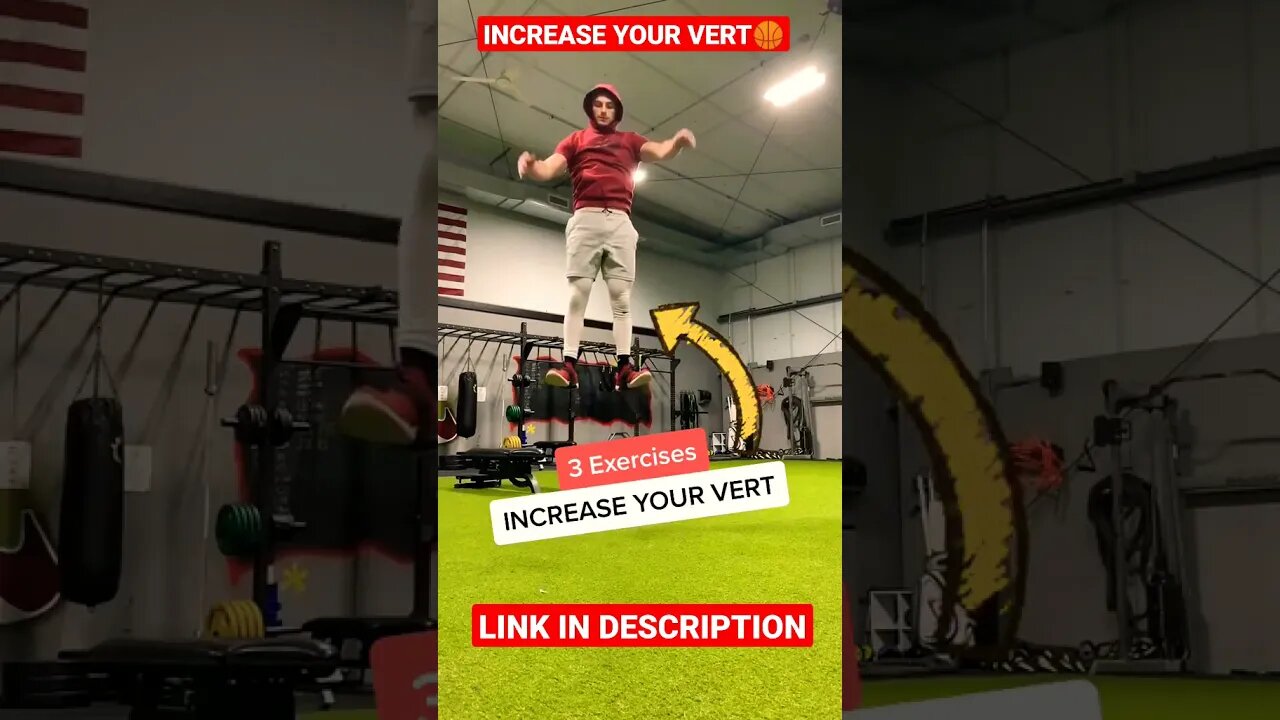Premium Only Content

3 EXERCISES TO INCREASE YOUR VERT🏀🚀 #Shorts
➡️ACCESS THE BEST VERTICAL JUMP PROGRAM 🔥
https://bit.ly/VerticallJumpTraining
➡️BEST Products To IMPROVE Your Training Performance⤵️
https://bit.ly/JumpHigherr
How to Improve Your Vertical Jump
Exercising
Practice
Hone Your Vertical Jump
A Word From Verywell
Is there a secret to improve your vertical jump? You may want to dunk like the pros or you may want to improve your jumping abilities for sports like tennis, volleyball, or track events such as the high jump.
According to Miami Heat Strength and Conditioning Coach Bill Foran, "Jumping is a very explosive movement that can, believe it or not, be improved with proper training." Most NBA players have vertical jumps in the 28-inch to 34-inch range.
To get your best vertical jump, it is necessary to do both strength and power training.
Exercising
Strength exercises include slow, controlled movements like squats, lunges, and weighted step-ups.
Power exercises require explosive, quick moves like those needed for plyometrics and power cleans.
Plyometrics are explosive bounding, hopping and jumping drills that blend strength and speed.
Finally, practicing maximum vertical jump will increase verticaTRAININ
There are many ways to improve vertical jump, but some of the most effective exercises include plyometrics, along with exercises that build both strength and power.
Plyometrics: The most common plyometric exercises include hops, jumps, and bounding movements.
One popular plyometric exercise is jumping off a box and rebounding off the floor and onto another, higher box.
Box jumps will also provide practice for jumping.
Full squats: This barbell exercise will build both strength and power. It's also one of the best total body exercises you can do.
Weighted/dynamic step-ups: The step-up is a great all-around exercise that you can do almost anywhere.
Not only will it build strength in your quadriceps, but you can also use it as part of a cardio workout. It has a low risk of injury.
Overhead walking lunges: This exercise builds power, strength, and speed in your legs as well as improving core strength during movement.
All you need is a weight and room to walk.
Single-leg squats: You can do single-leg squats anywhere, without equipment.
It works your hips, hamstrings, quadriceps, gluteus maximus, and calves while strengthening your core and helping flexibility.
Sprints: These short bouts of intense exercise build muscle and performance, using more muscles at the same time as compared to weightlifting.
Agility drills: Agility drills—several of which include jumping—help improve coordination, speed, power, and specific sports skills
Stair running: This high-intensity workout helps build speed, power, and cardiovascular fitness.
It targets the glutes, quads, and calves.
You can build strength by performing basic weight training exercise using slow, controlled movements, and build power with faster dynamic movements.
You also you need to improve the speed of movement in order to create power.
This is done with explosive, quick exercises.
You can add specific plyometric drills as well.
These build both power and speed and generally include explosive bounding, hopping, and jumping exercises.
Practice
Include some time to practice your maximum jump, putting it all together.
Work on your form, incorporating your lead up to the jump, arm motion, and safe landing technique.
Follow these basic tips and techniques to keep your joints safe and achieve the maximum vertical jump:
Always warm-up before doing and jumping test or drills. Many athletes jump rope to get the blood flowing and warm up the muscles.
Do several slow, controlled toe raises to prepare the feet and ankles for jumping and landing.
Work your way up to a full vertical jump, by doing box jumps and squat jumps first.
Hone Your Vertical Jump
When finally working on the vertical jump, be sure to start with the feet hips-distance apart.
If measuring your jump height, stand about a foot away from the measuring tape (with the tape or measuring bar on your side).
Do a warm up arm swing before the jump.
That is, start with arms overhead, swing the arms behind the hips as you drop into a squat then swing back up to the starting position before going right into another drop/swing for the full jump. This "pre-swing" helps to build momentum.
Your hips do not stay level when you measure your jump. The hip closest to the measuring tip will lift to allow you to fully extend the arm on that side to reach as high as possible.
Be sure to land with the knees bent to minimize the impact.
A Word From Verywell
Keep in mind that jumping is a high-impact activity.
It isn't suitable for everyone and you may discover it is taking a toll on your knees, hips, ankles, and feet.
Be sure to give your body a rest between hard workouts so your muscles have time to repair and build before you challenge them again.
HOW TO JUMP HIGHER ‼️🔥🚀 #Shorts
-
 LIVE
LIVE
Dr. Drew
5 hours agoCharlie Sheen Shouldn't Be Alive: His Unfiltered Story of Fame, Addiction & Recovery + Dr. Aaron Kheriaty on Canada's Plan To Euthanize 12-Year-Olds – Ask Dr. Drew
1,744 watching -
 LIVE
LIVE
Dr Disrespect
7 hours ago🔴LIVE - DR DISRESPECT - ARC RAIDERS - NORTH LINE UPDATE
1,542 watching -
 8:10
8:10
Buddy Brown
6 hours ago $0.50 earned5 Things Your Pastor WON'T TEACH YOU at Church! | Buddy Brown
1.97K5 -
 LIVE
LIVE
LFA TV
20 hours agoLIVE & BREAKING NEWS! | THURSDAY 11/13/25
1,115 watching -
 LIVE
LIVE
freecastle
7 hours agoTAKE UP YOUR CROSS- Commit your way to the Lord; trust in him, and he will act!
95 watching -
 30:28
30:28
The White House
7 hours agoPresident Trump and the First Lady Participate in an Executive Order Signing
34.4K23 -
 1:13:56
1:13:56
DeVory Darkins
5 hours agoNewsom SUFFERS MAJOR SETBACK after Trump revokes 17,000 Commercial Drivers Licenses
155K63 -
 1:07:32
1:07:32
Timcast
6 hours agoDemocrats CAUGHT Framing Trump On Epstein, Leaked Emails Show Journalist COLLUSION :+1: 1
195K207 -
 2:22:37
2:22:37
The Bold Lib
3 hours agoBOLDCHAT: Moms For Liberty | Free Speech w/ANGELA BELCAMINO
26.2K2 -
 2:11:09
2:11:09
Steven Crowder
8 hours ago🔴 Just Release the Damn Epstein Files - End It Once and For All
574K531